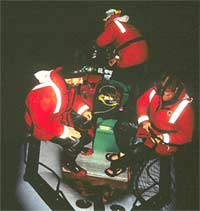|

Extraordinary
measures, fishing for murrelets with a salmon net in the
dark of night, a bad breeding year, and no waiting for the
molt
AÑO
NUEVO, CALIFORNIA - Wildlife
biology field work comes in a variety of different shapes
and sizes. Most of the projects with which I have been involved
or observed have employed field techniques that involve
a considerable amount of excitement. Many wildlife taxa
have evolved behavioral and physical attributes such as
flight, the ability to burrow, or the ability to survive
in climates not hospitable to humans that can make studying
them quite challenging. Researchers therefore are often
forced to go to extraordinary lengths to observe, capture,
or sample their study species.
| |
 |
 |
Ask
the Author:
Zach
Peery has agreed to answer your questions, time permitting.
Email
Zach.
|
Murrelets are no exception. They only fly around over land
when it is dark or nearly dark, they fly very fast (30 mph),
and they don't vocalize when they land. At-sea they are
usually found close to shore, near the surf and are not
very approachable during the day. That means that in order
to catch them, we are forced to try to catch them on the
water at night. Obviously doing so can be pretty tough.
Nevertheless, catching murrelets is fun. Actually, it is
a lot of fun.
| |

Zach
Peery and colleagues working offshore in the dark of
night in the Zodiac
|
Catching murrelets takes a boat - in our case, a Zodiac
- and a three person crew. The crew consists of one driver,
one person holding a spotlight, and one person holding a
large salmon net at the ready. Once we launch off the beach,
then we cruise along parallel to the coast approximately
400 yards from shore using the spotlight to locate birds.
When someone spots a group of birds, the person who located
them yells "Bird!" and the "netter"
hangs over the bow trying literally to scoop the birds out
of the water as the driver inches closer. Believe it or
not, sometimes it actually works. Unfortunately, when we
went out in Año Nuevo Bay last week, we only caught
one bird. It wasn't because we missed a lot of birds, there
simply weren't many around. It appears to be a bad breeding
year, and many birds simply may not be hanging out adjacent
to their onshore nesting habitat.
We generally have pretty good success though. On a good
night we have caught up to 12 birds and have caught approximately
260 overall since 1997. The goal this year is to catch 75
more, and we have caught 17 up to this point. We expect
to have better success in the fall when birds tend to congregate
in Año Nuevo and when they molt their flight feathers
and can no longer fly ...
—
Zach Peery
|





